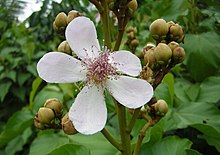
The Cucurbitales are an order of flowering plants, included in the rosid group of dicotyledons. This order mostly belongs to tropical areas, with limited presence in subtropical and temperate regions. The order includes shrubs and trees, together with many herbs and climbers. One major characteristic of the Cucurbitales is the presence of unisexual flowers, mostly pentacyclic, with thick pointed petals. The pollination is usually performed by insects, but wind pollination is also present.
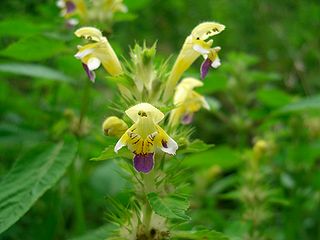
The order Lamiales are an order in the asterid group of dicotyledonous flowering plants. It includes about 23,810 species, 1,059 genera, and is divided into about 25 families. These families include Acanthaceae, Bignoniaceae, Byblidaceae, Calceolariaceae, Carlemanniaceae, Gesneriaceae, Lamiaceae, Lentibulariaceae, Linderniaceae, Martyniaceae, Mazaceae, Oleaceae, Orobanchaceae, Paulowniaceae, Pedaliaceae, Peltantheraceae, Phrymaceae, Plantaginaceae, Plocospermataceae, Schlegeliaceae, Scrophulariaceae, Stilbaceae, Tetrachondraceae, Thomandersiaceae, Verbenaceae.

The Malvales are an order of flowering plants. As circumscribed by APG II-system, the order includes about 6000 species within nine families. The order is placed in the eurosids II, which are part of the eudicots.
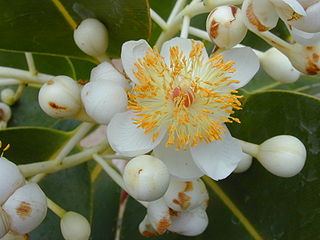
The Malpighiales comprise one of the largest orders of flowering plants, containing about 36 families and more than 16,000 species, about 7.8% of the eudicots. The order is very diverse, containing plants as different as the willow, violet, poinsettia, manchineel, rafflesia and coca plant, and are hard to recognize except with molecular phylogenetic evidence. It is not part of any of the classification systems based only on plant morphology. Molecular clock calculations estimate the origin of stem group Malpighiales at around 100 million years ago (Mya) and the origin of crown group Malpighiales at about 90 Mya.

Ceratophyllaceae is a cosmopolitan family of flowering plants including one living genus commonly found in ponds, marshes, and quiet streams in tropical and in temperate regions. It is the only extant family in the order Ceratophyllales. Species are commonly called coontails or hornworts, although hornwort is also used for unrelated plants of the division Anthocerotophyta.

The Buxales are a small order of eudicot flowering plants, recognized by the APG IV system of 2016. The order includes the family Buxaceae; the families Didymelaceae and Haptanthaceae may also be recognized or may be included in the Buxaceae. Many members of the order are evergreen shrubs or trees, although some are herbaceous perennials. They have separate "male" (staminate) and "female" (carpellate) flowers, mostly on the same plant. Some species are of economic importance either for the wood they produce or as ornamental plants.

Violaceae is a family of flowering plants established in 1802, consisting of about 1000 species in about 25 genera. It takes its name from the genus Viola, the violets and pansies.

Violales is a botanical name of an order of flowering plants and takes its name from the included family Violaceae; it was proposed by Lindley (1853). The name has been used in several systems, although some systems used the name Parietales for similar groupings. In the 1981 version of the influential Cronquist system, order Violales was placed in subclass Dilleniidae with a circumscription consisting of the families listed below. Some classifications such as that of Dahlgren placed the Violales in the superorder Violiflorae.
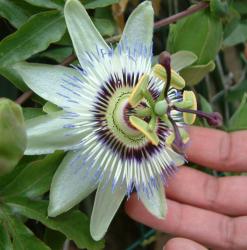
The Passifloraceae are a family of flowering plants, containing about 750 species classified in around 27 genera.

Asphodelaceae is a family of flowering plants in the order Asparagales. Such a family has been recognized by most taxonomists, but the circumscription has varied widely. In its current circumscription in the APG IV system, it includes about 40 genera and 900 known species. The type genus is Asphodelus.

Turneraceae Kunth ex DC. is a family of flowering plants consisting of 120 species in 10 genera. The Cronquist system placed the Turneracids in the order Violales, but it is not currently recognized as a family by the Angiosperm Phylogeny Group in the APG III system of 2009, which includes the taxa in the Turneraceae in Passifloraceae as a subfamily (Turneroideae).

Asparagaceae, known as the asparagus family, is a family of flowering plants, placed in the order Asparagales of the monocots. The family name is based on the edible garden asparagus, Asparagus officinalis. This family includes both common garden plants as well as common houseplants. The garden plants include asparagus, yucca, bluebell, and hosta, and the houseplants include snake plant, corn cane, spider plant, and plumosus fern.
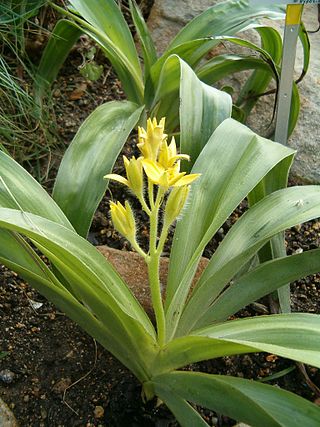
Hypoxidaceae is a family of flowering plants, placed in the order Asparagales of the monocots.

Dasypogonaceae is a family of flowering plants based on the type genus Dasypogon, one that has traditionally not been commonly recognized by taxonomists; the plants it contains were usually included in the family Xanthorrhoeaceae. If valid, Dasypogonaceae includes four genera with 16 species. The family is endemic to Australia. The best known representative is Kingia australis.
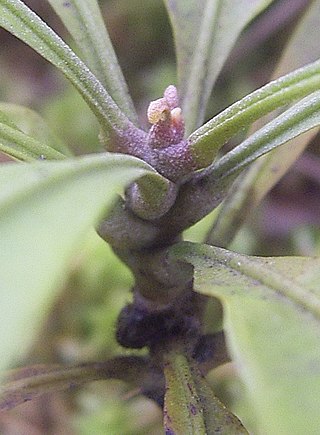
The Dioncophyllaceae are a family of flowering plants consisting of three species of lianas native to the rainforests of western Africa.
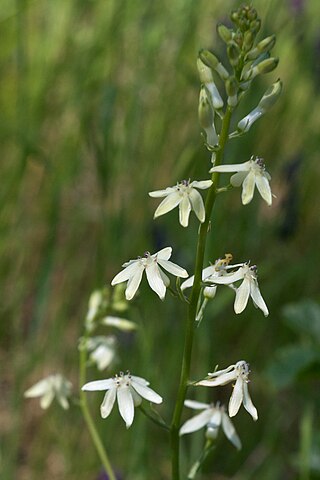
Tecophilaeaceae is a family of flowering plants, placed in the order Asparagales of the monocots. It consists of nine genera with a total of 27 species.

The Cochlospermaceae were a family of two genera and 20-25 species of trees and shrubs, first described by Jules Émile Planchon in 1847. They have been included in the Bixaceae from the APG III system onwards. The older APG II system treated this family as an optional segregate of Bixaceae. They occur widely throughout the tropical regions of the world, but are curiously absent from Malaysia. Most species in this family are mesophytic or xerophytic, growing primarily in drier climates.

Huaceae is a family of plant in the rosids group, which has been classed in the orders Malpighiales, Malvales, and Violales or in its own order Huales. The APG II system placed it in the clade eurosids I, whereas the APG III system of 2009 and APG IV (2016) place it within the Oxalidales. The family is endemic to central Africa. It contains four species in the following two genera:
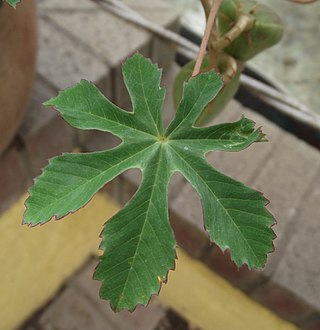
Amoreuxia gonzalezii is a rare species of flowering plant in the Bixaceae known by the common names Santa Rita mountain yellowshow, Santa Rita throwup weed, saiya and temaqui. It is native to Sonora in Mexico, its distribution extending just above the border into Arizona in the United States, where it occurs in the Santa Rita Mountains of Pima and Santa Cruz Counties. It has also been found in the States of Sinaloa and Jalisco to the south. It is also present in the Sierra de la Laguna of Baja California Sur.

Amoreuxia is a genus of flowering plants in the achiote family, Bixaceae. It was formerly placed in the family Cochlospermaceae. Members of the genus are commonly known as yellowshow. They are native to Mexico, Central America, Colombia, Peru, Curaçao, and the southwestern United States.
- Amoreuxia gonzaleziiSprague & L.Riley – Santa Rita Mountain yellowshow - Sonora, Sinaloa, Jalisco, southern Arizona
- Amoreuxia malvifoliaA.Gray - Chihuahua, Durango
- Amoreuxia palmatifidaMoc. & Sessé ex DC. – Mexican yellowshow - Mexico, Central America, Colombia, Arizona, New Mexico
- Amoreuxia wrightiiA.Gray – Wright's yellowshow - Curaçao, Peru, Chihuahua, Durango, Coahuila, Nuevo León, San Luis Potosí, Tamaulipas, Campeche, Yucatán, Quintana Roo, Campeche, Texas
